G.Skill Trident Z5 RGB DDR5-6400 C32 Review: Top Performance At a Top-Dollar Price
Despite all the benefits that DDR5 brings to the forefront, the new memory standard didn’t start off on the right foot. The fact is that DDR5 debuted in the middle of a global semiconductor shortage, which hindered its adoption rate due to inflated pricing. However, pricing for DDR5 memory kits has improved, but there is still a long way to go before it’s competitive with DDR4 pricing; therefore, consumers are reluctant to jump on the bandwagon. Moreover, DDR5 is still wet behind the ears and struggles to compete with high-end DDR4. However, it’s slowly getting there, and G.Skill’s recent Trident Z5 RGB DDR5-6400 C32 memory kit is a testimony that DDR5 is progressing in the right direction.
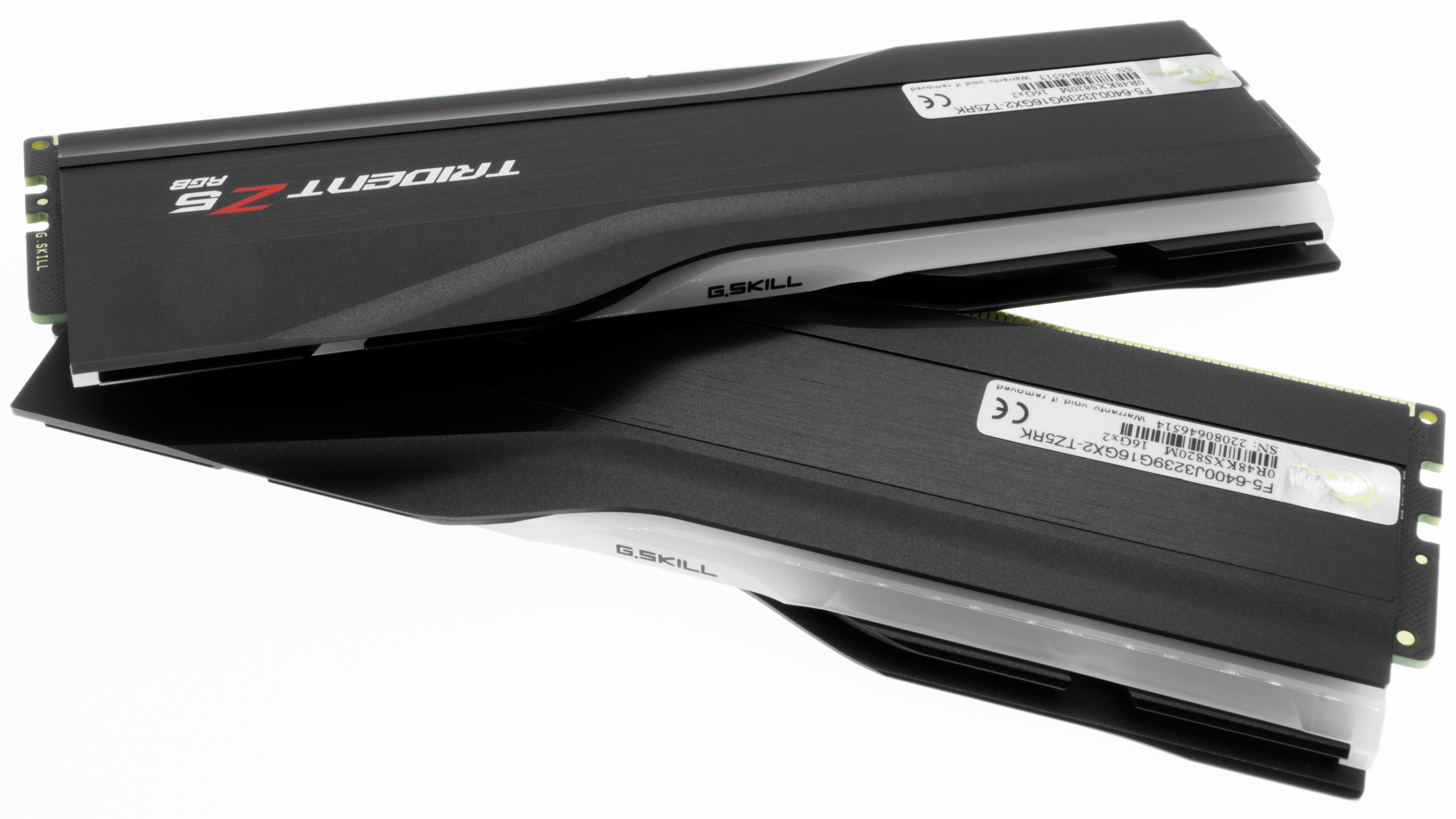
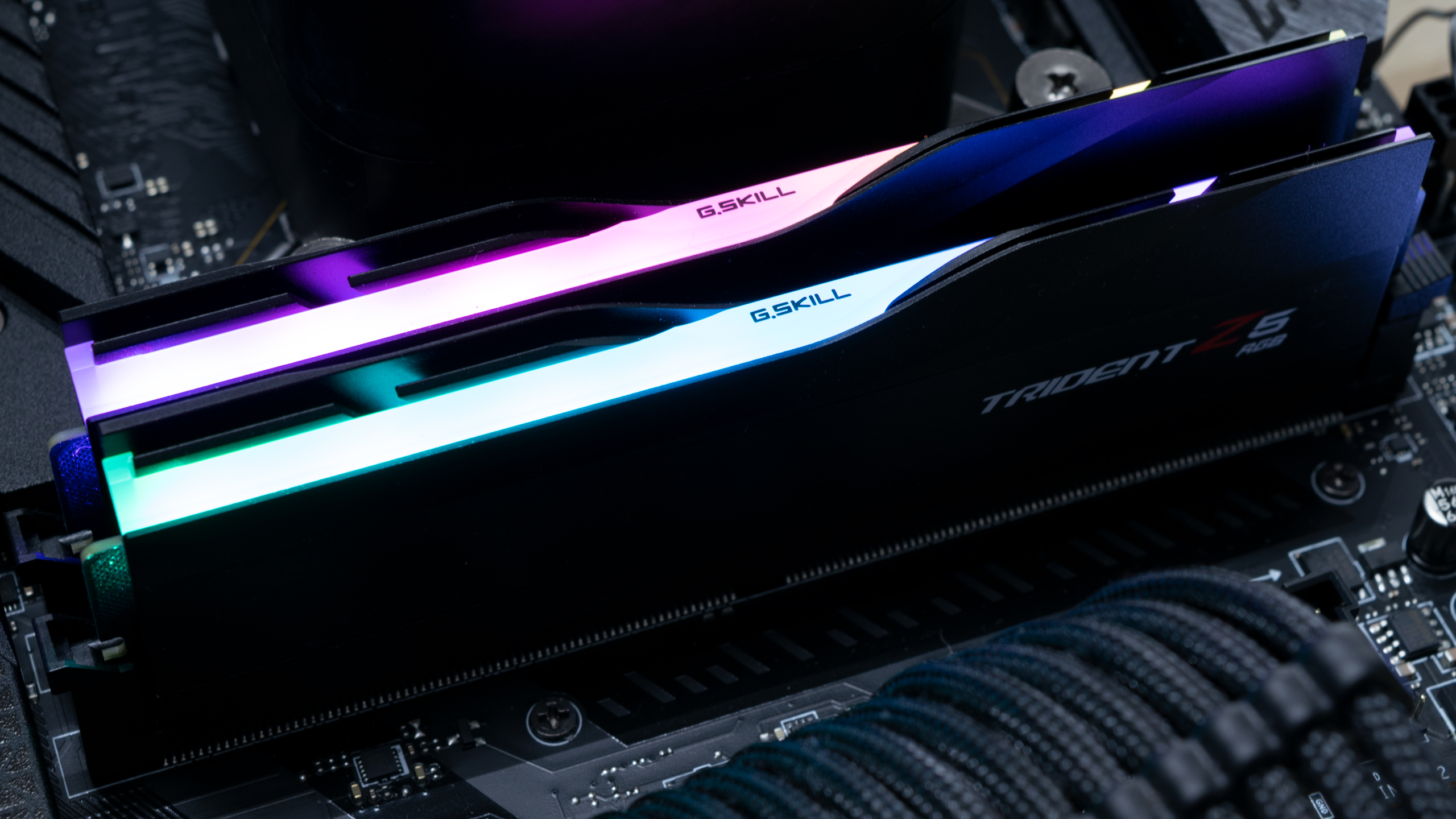
G.Skill’s Trident Z5 RGB memory is among the best-looking DDR5 kits around. The memory comes in two flavors: metallic silver or matte black. On this occasion, we’re taking a look at the latter. Unlike the metallic silver variant that features silver and black tones, the matte black version sports an all-black aluminum heat spreader.
The heat spreader with the translucent RGB light bar on the Trident Z5 RGB isn’t offensively tall; however, the memory module has a height of 42mm (1.65 inches), so you should double-check for compatibility issues either way. You can tweak the lighting using G.Skill’s lightweight Trident Z Lighting Control software or your motherboard. The compatibility list includes Asus Aura Sync, Gigabyte RGB Fusion 2.0, MSI Mystic Light Sync, and ASRock Polychrome Sync.


The Trident Z5 RGB DDR5-6400 memory modules incorporate SK hynix’s H5CG48MEBDX014 (M-die) integrated circuits (ICs). In addition, the power management IC (PMIC) has the “0D=8M 24A” marking. After dumping the memory’s SPD through the CPU-Z software, we found out that Richtek is the maker of this unit.
Like any overclocked DDR5, G.Skill’s memory kit will default to DDR5-4800 with 40-40-40-76 timings. The XMP 3.0 profile configures the data rate up to DDR5-6400, timings to 32-39-39-102, and applies 1.4V to the DRAM voltage. See our PC Memory 101 feature and our How to Shop for RAM story for more on timings and frequency considerations.
Comparison Hardware
| Memory Kit | Part Number | Capacity | Data Rate | Primary Timings | Voltage | Warranty |
|---|---|---|---|---|---|---|
| G.Skill Trident Z5 RGB | F5-6400J3239G16GX2-TZ5RK | 2 x 16GB | DDR5-6400 (XMP) | 32-39-39-102 (2T) | 1.40 | Lifetime |
| G.Skill Trident Z5 RGB | F5-6000U3636E16GX2-TZ5RS | 2 x 16GB | DDR5-6000 (XMP) | 36-36-36-76 (2T) | 1.30 | Lifetime |
| TeamGroup T-Force Delta RGB | FF3D516G6000HC40ABK | 2 x 16GB | DDR5-6000 (XMP) | 40-40-40-80 (2T) | 1.35 | Lifetime |
| Corsair Dominator Platinum RGB DDR5 | CMT32GX5M2B5200C38 | 2 x 16GB | DDR5-5200 (XMP) | 38-38-38-84 (2T) | 1.25 | Lifetime |
| Kingston Fury Beast | KF552C40BBK2-32 | 2 x 16GB | DDR5-5200 (XMP) | 40-40-40-80 (2T) | 1.25 | Lifetime |
| Crucial | CT2K8G48C40U5 | 2 x 8GB | DDR5-4800 | 40-39-39-77 (2T) | 1.10 | Lifetime |
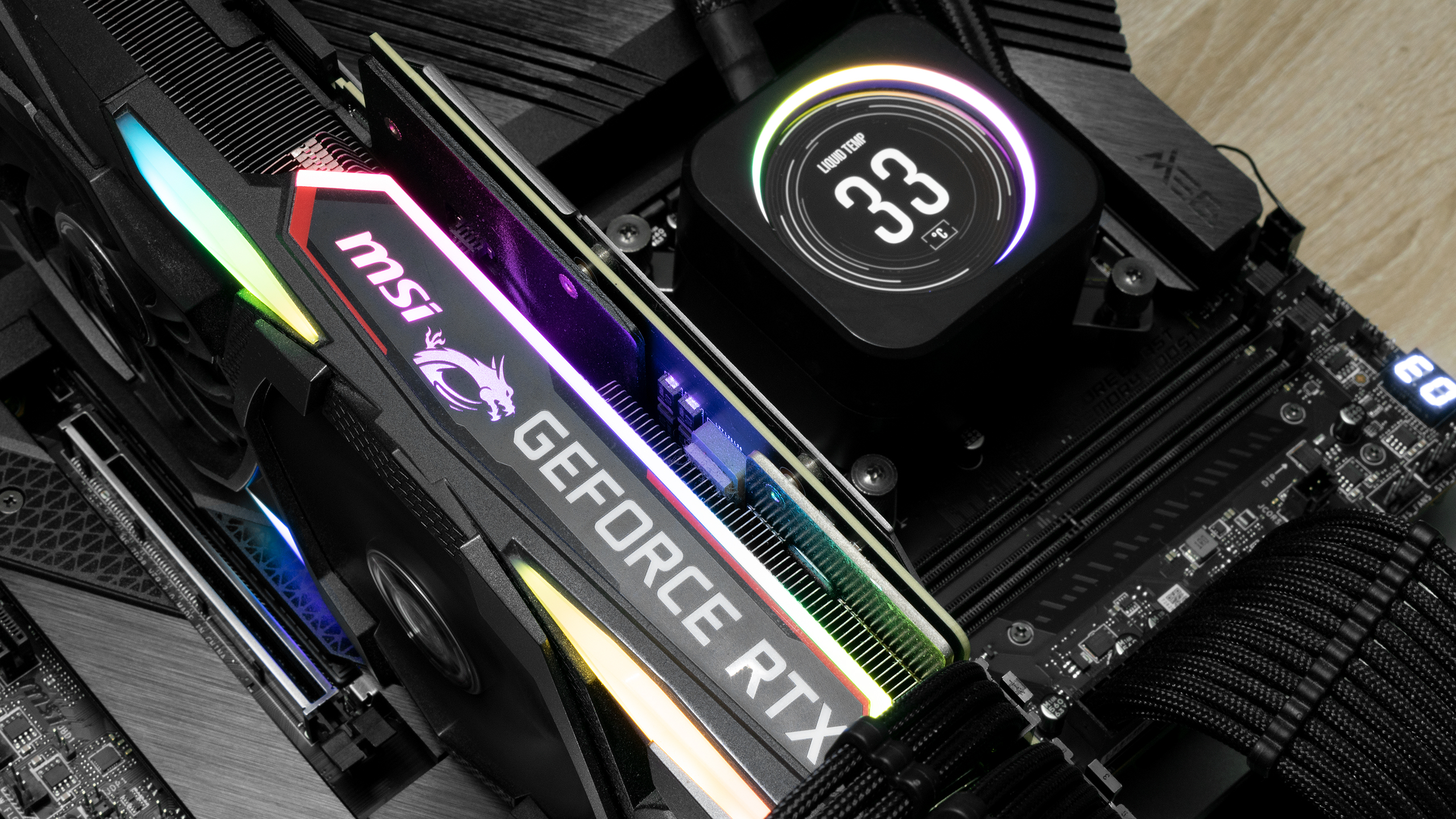
Our DDR5 test system leverages Intel’s Core i9-12900K processor with Corsair’s CUE H100i Elite LCD liquid cooler taking care of the cooling. The flagship Alder Lake chip resides on the MSI MEG Z690 Unify-X motherboard, running the 7D32vH0 firmware. Meanwhile, the MSI GeForce RTX 2080 Ti Gaming Trio is responsible for our gaming RAM benchmarks.
Our Windows 11 installation, benchmarking software, and games are stored on Crucial’s MX500 SSDs, whereas the RM650x feeds our entire system with the necessary juice. Lastly, the Streacom BC1 open bench table houses all of our hardware.
| Intel DDR5 System | |
|---|---|
| Processor | Intel Core i9-12900K |
| Motherboard | MSI MEG Z690 Unify-X |
| Graphics Card | MSI GeForce RTX 2080 Ti Gaming X Trio |
| Storage | Crucial MX500 500GB, 2TB |
| Cooling | Corsair iCUE H100i Elite LCD |
| Power Supply | Corsair RM650x 650W |
| Case | Streacom BC1 |
Intel Performance

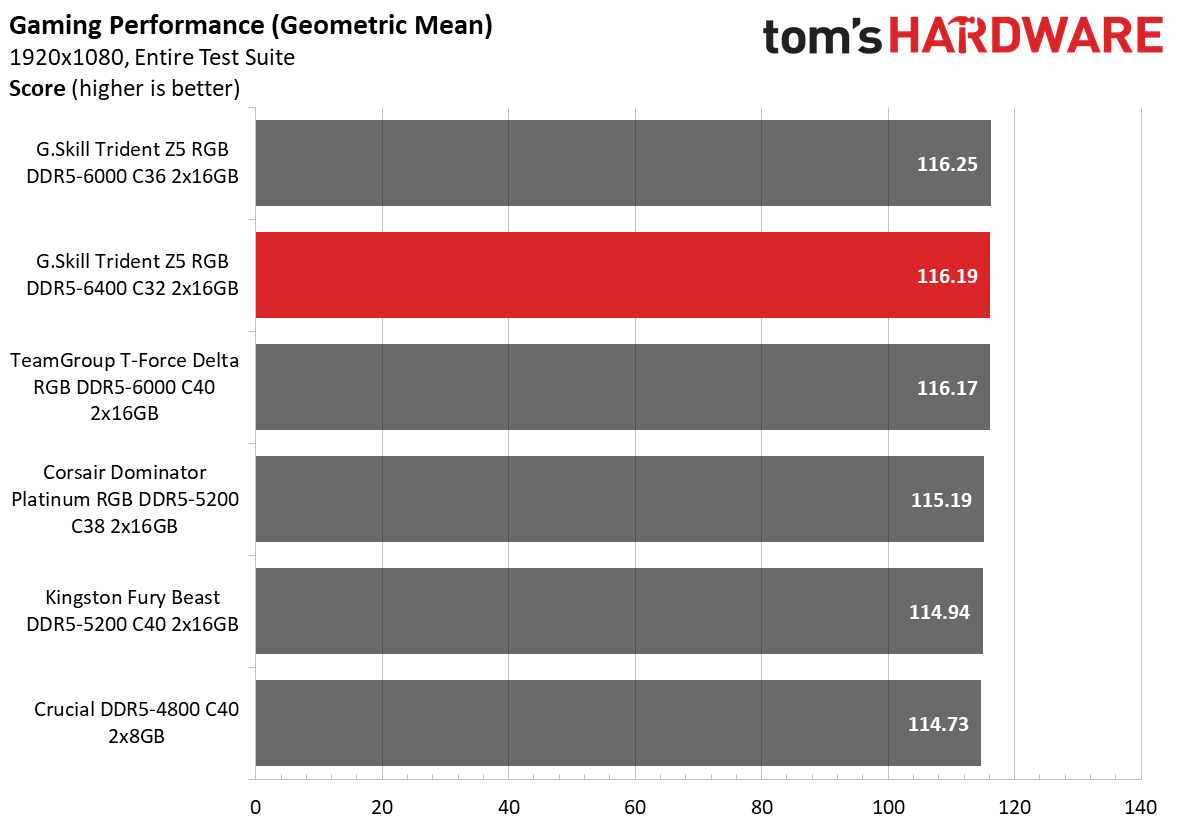
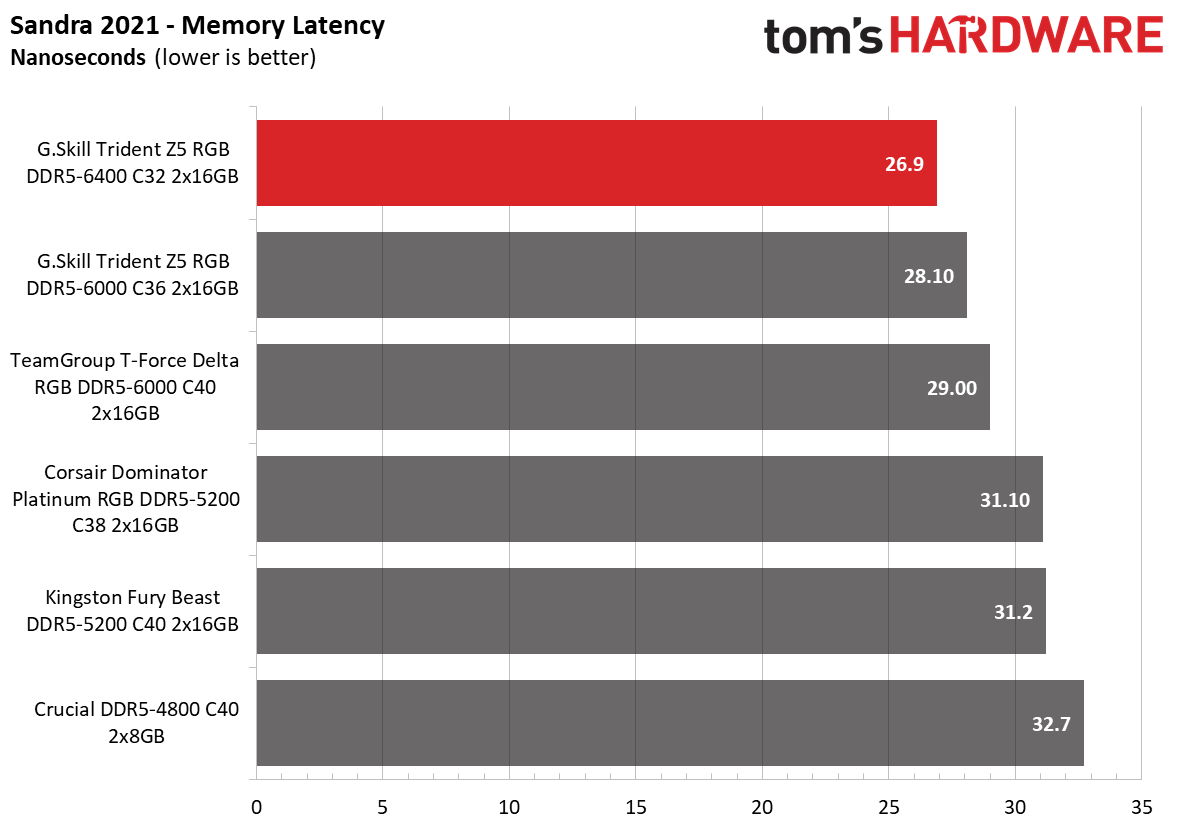

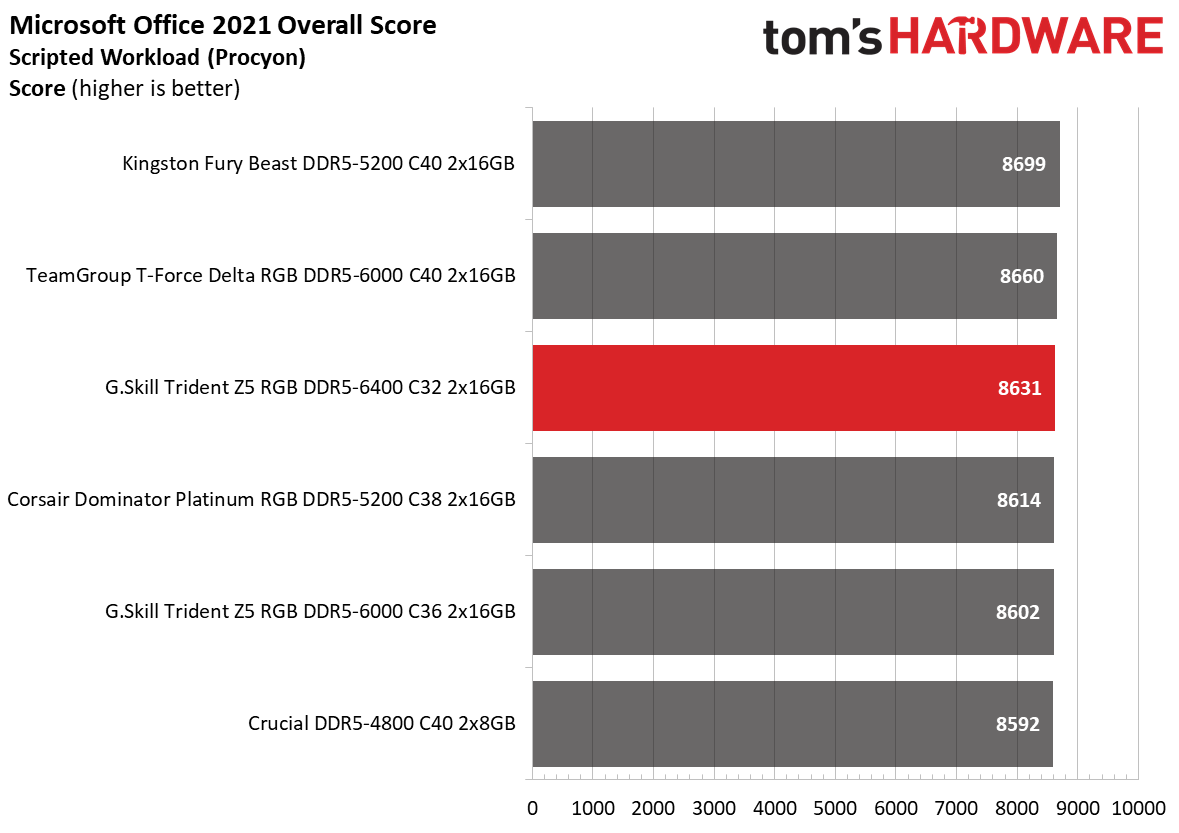

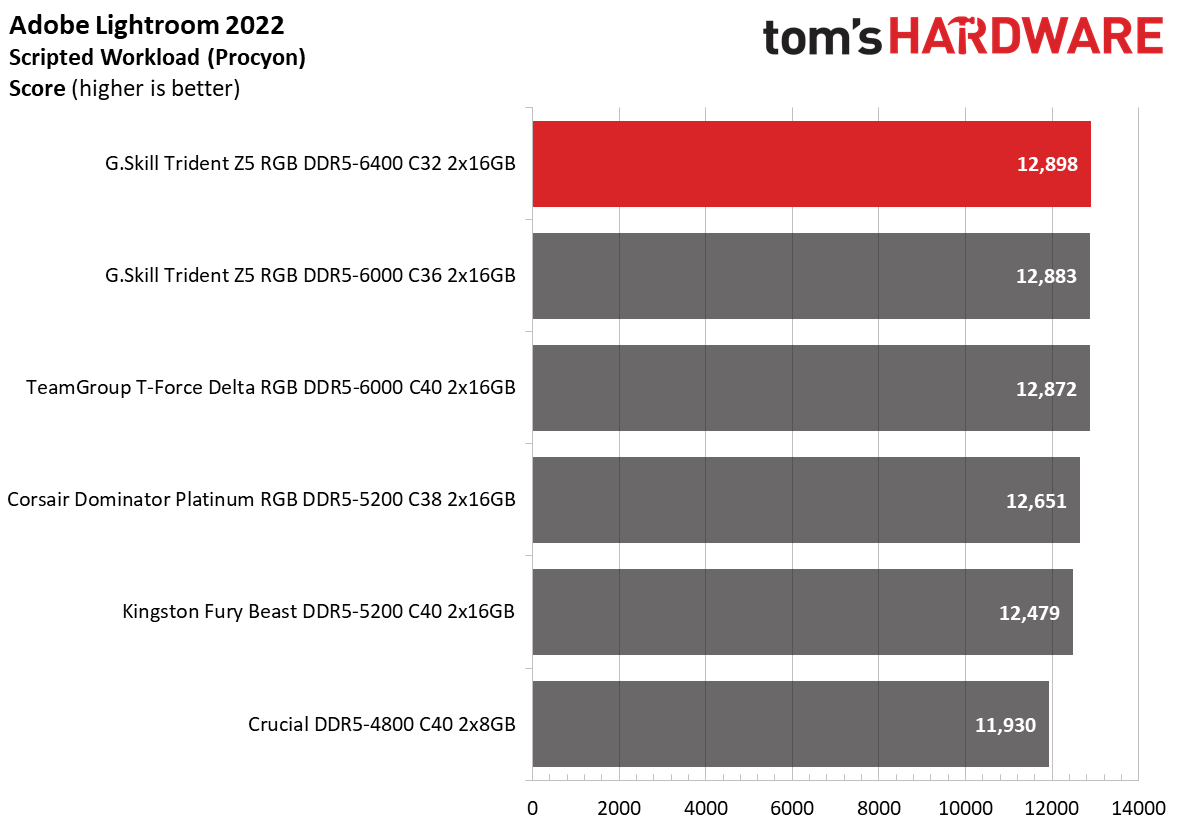

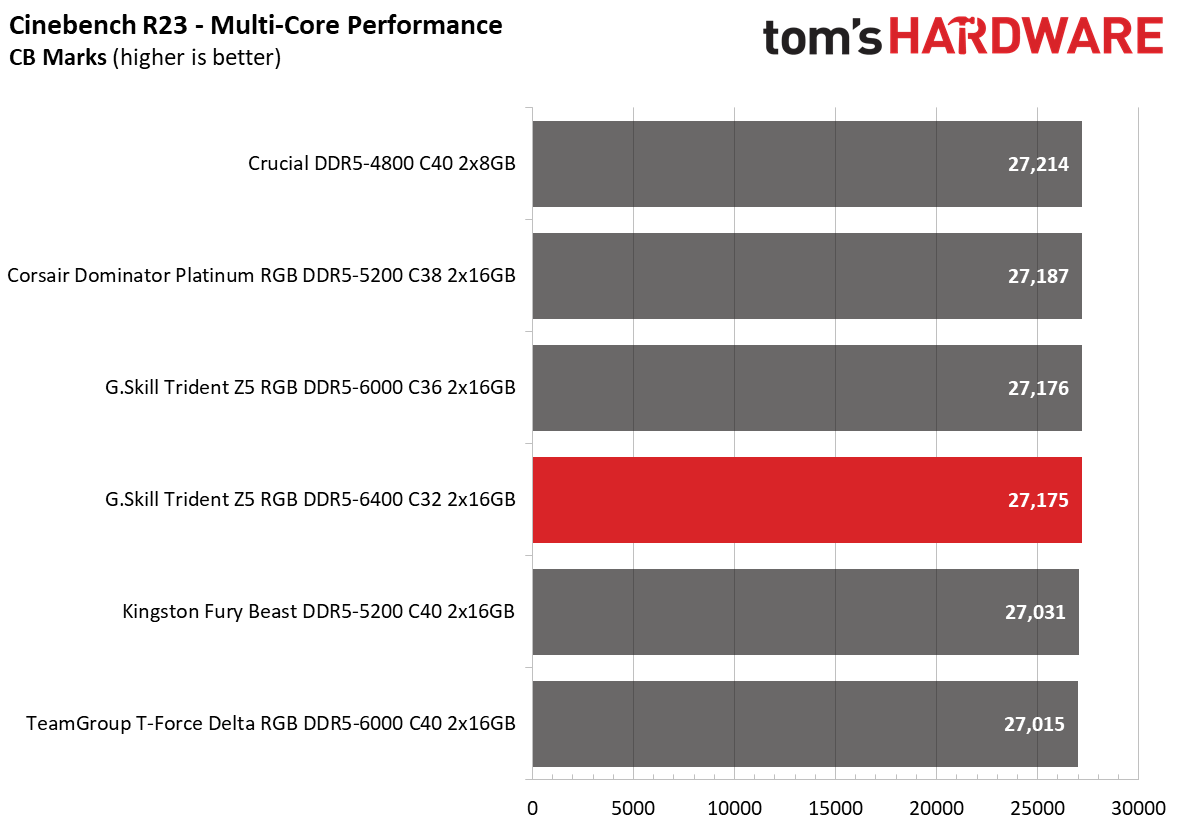
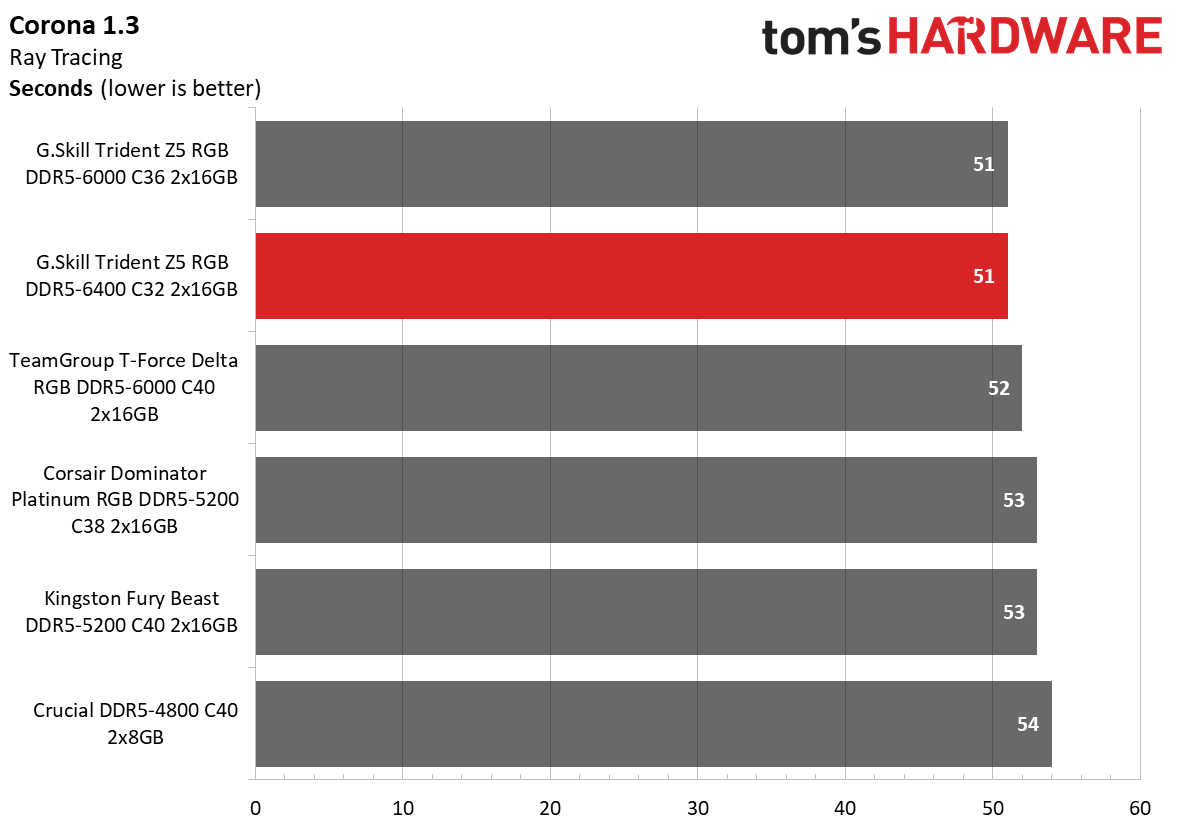
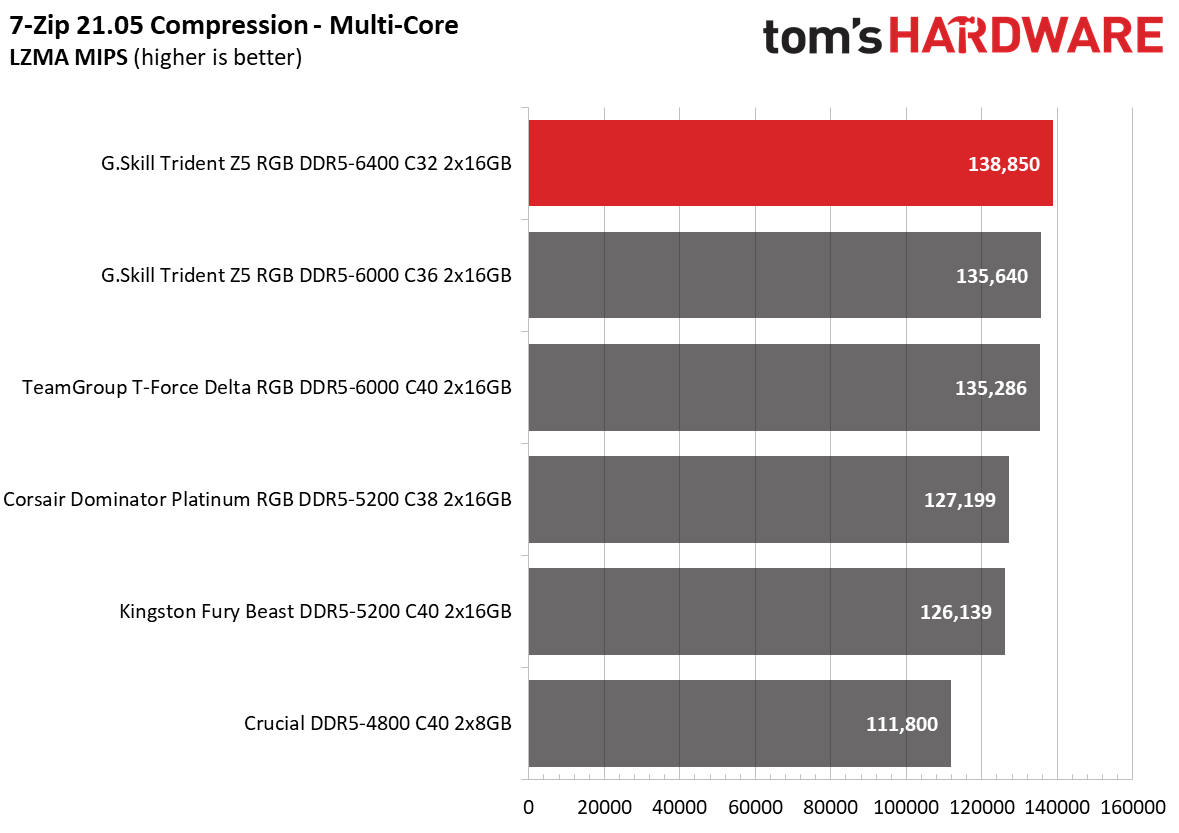
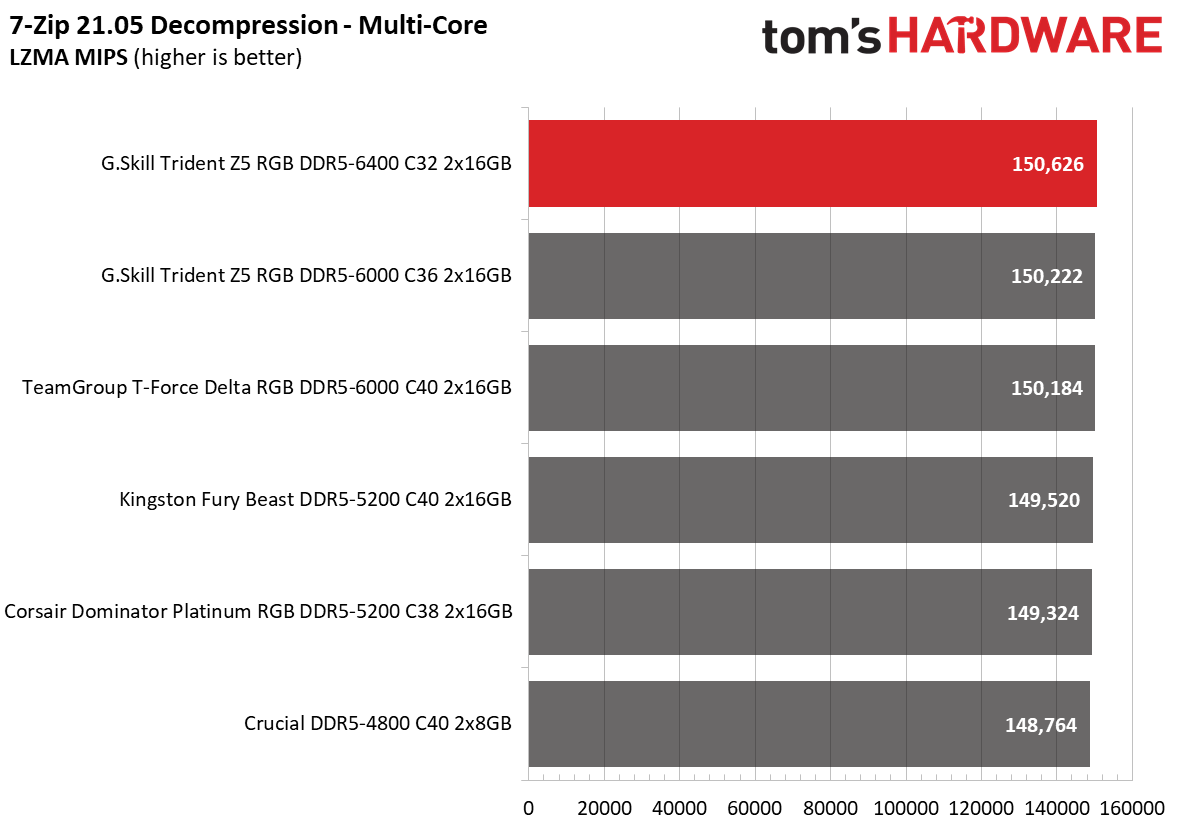
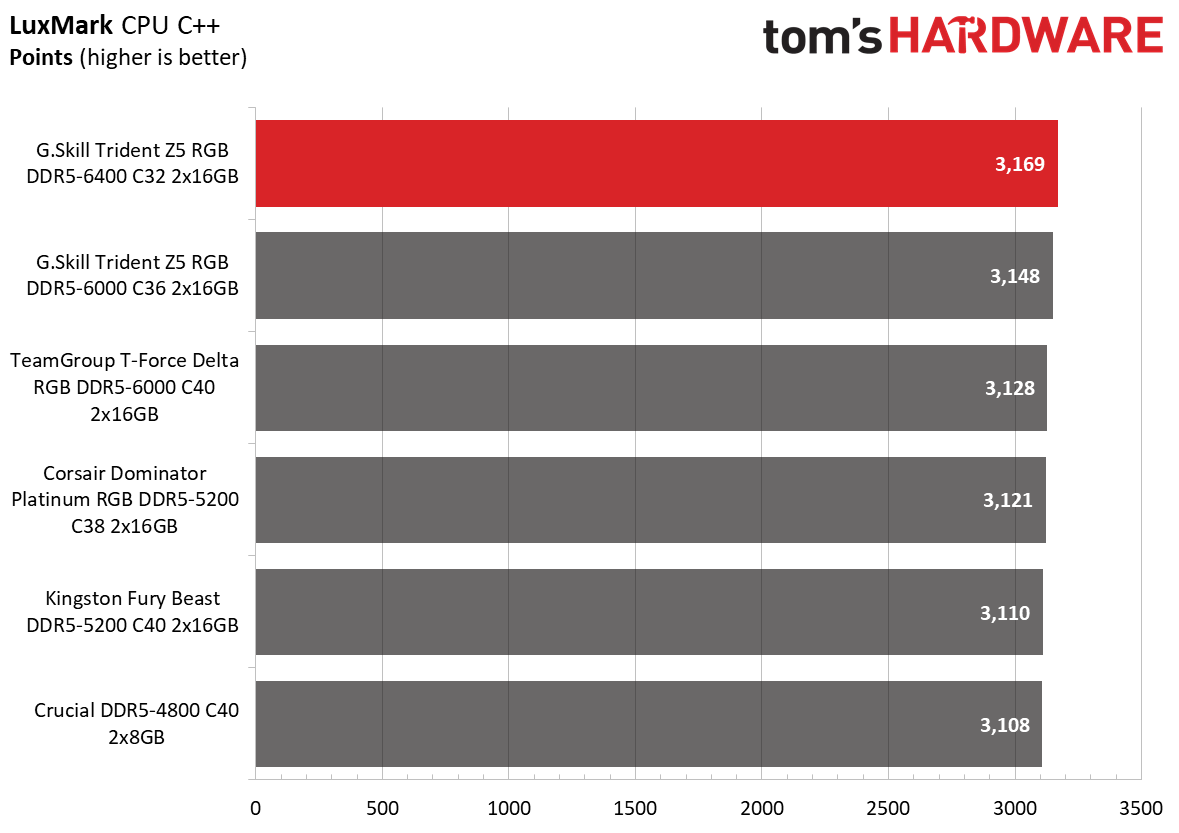

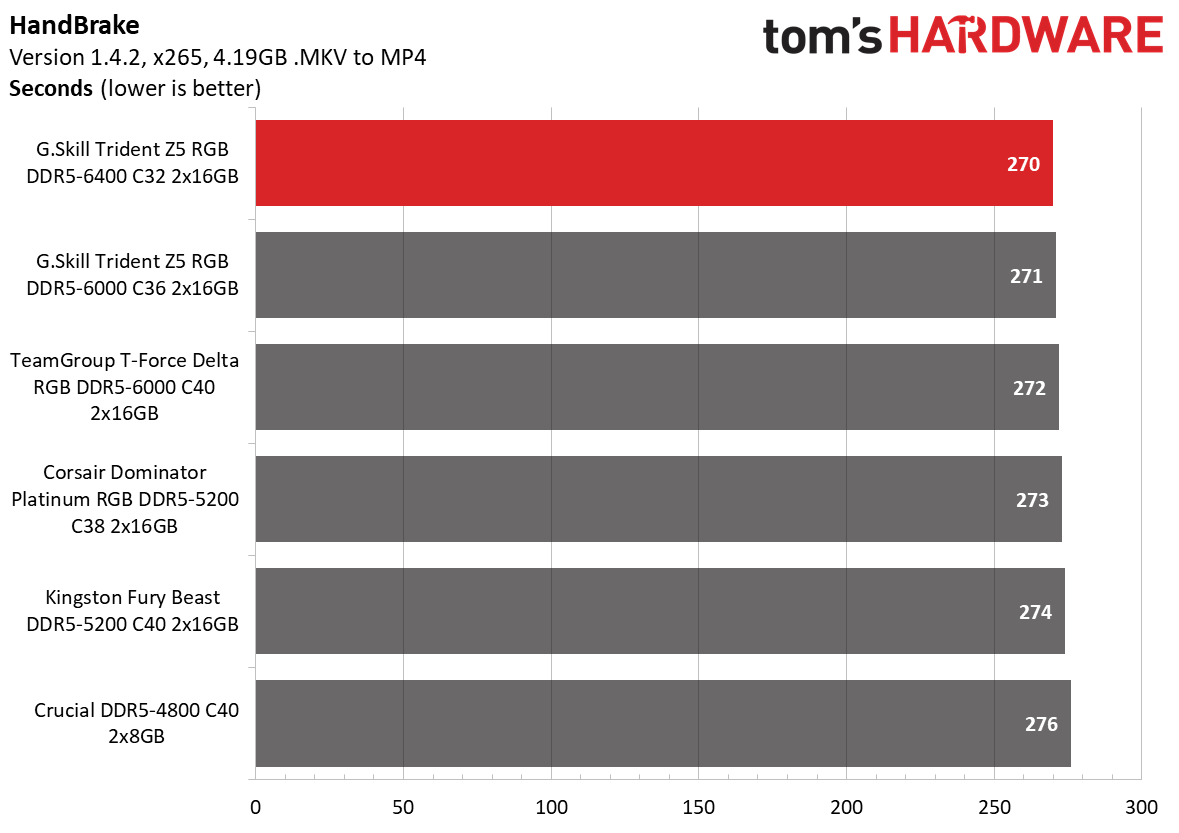
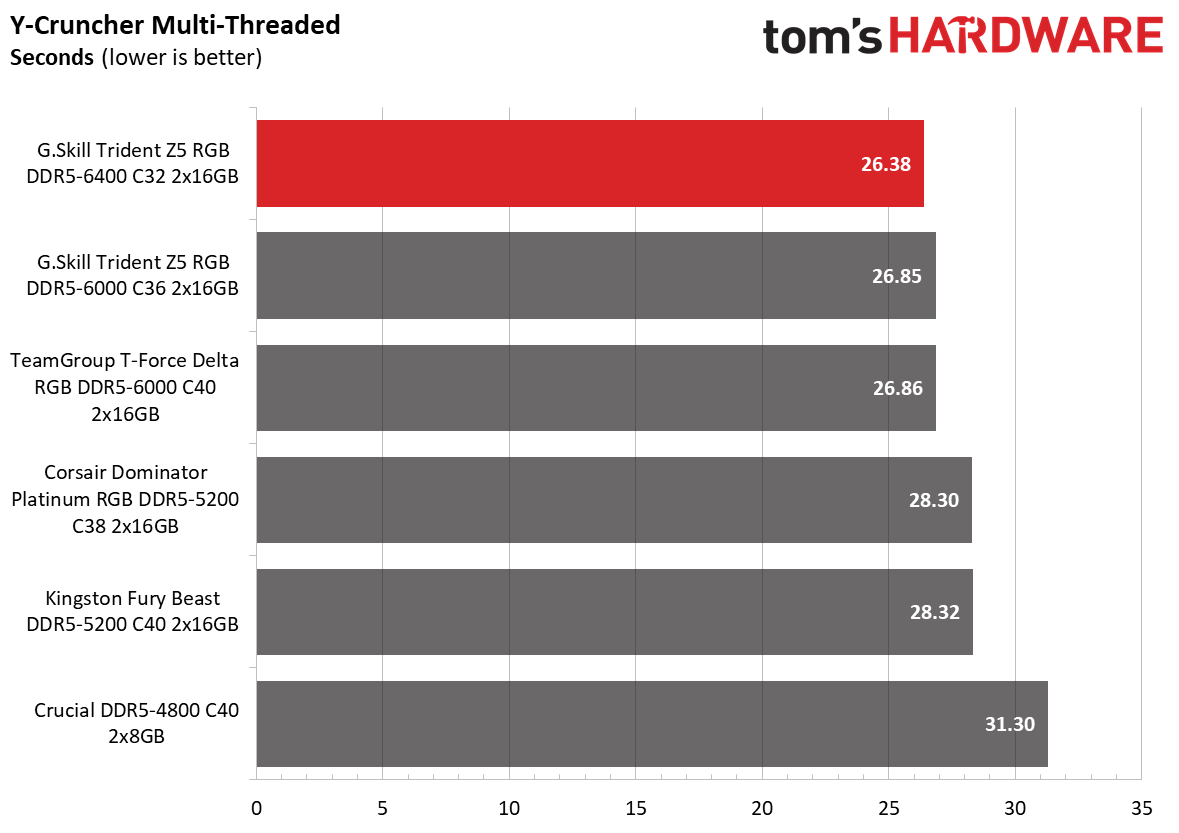

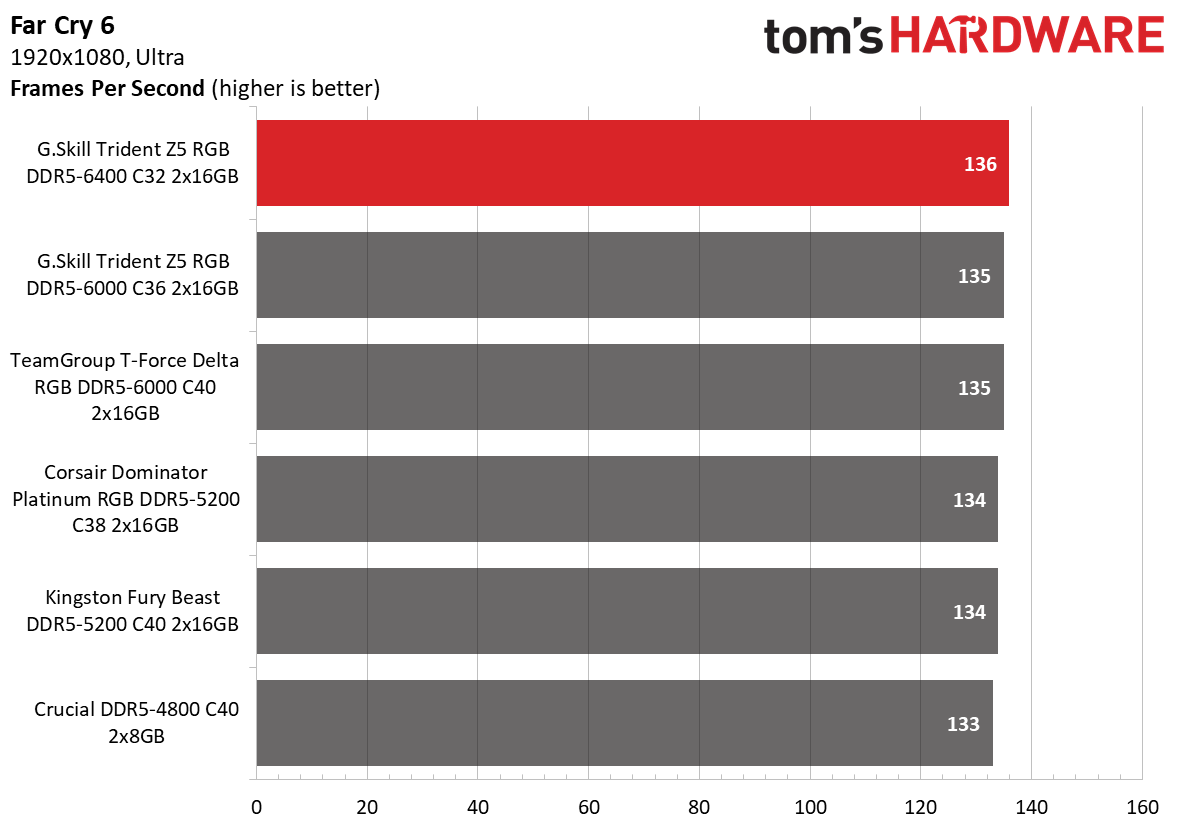
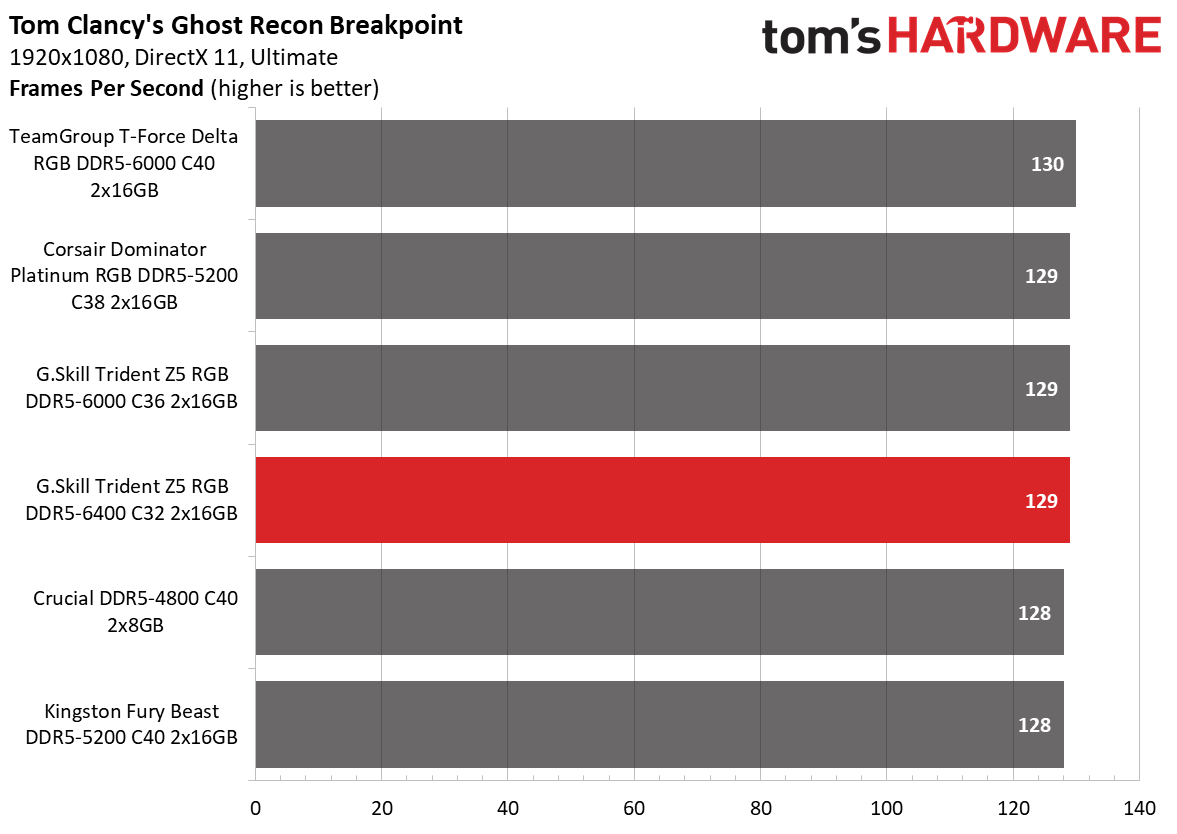

G.Skill’s memory kit boasted excellent performance, clinching the top spot in our application performance chart. The Trident Z5 RGB DDR5-6400 C32 excelled in most of the benchmarks except for Cinebench R23, where it came in fourth.
DDR5 speeds don’t make a huge difference in gaming performance. Nonetheless, the Trident Z5 RGB was only second to G.Skill’s own Trident Z5 RGB DDR5-6000 C36.
Overclocking and Latency Tuning
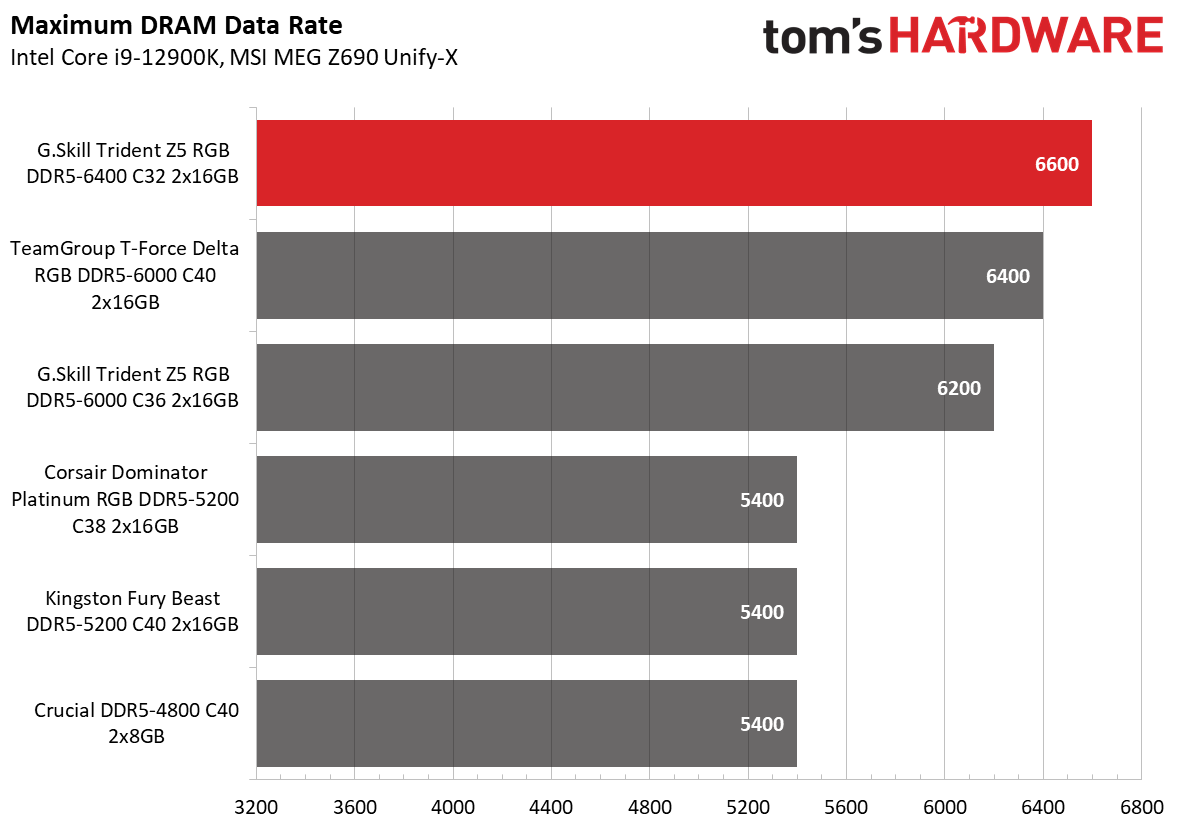


When you run hardware outside of the manufacturer’s specifications, there’s always a potential risk of damage. That’s the standard caveat with overclocking any piece of hardware, not just memory. We’ve already reached out to SK hynix to inquire about the maximum safe voltage for its ICs, but we haven’t received any feedback on safe voltages for overclocking. However, after speaking with various memory vendors, they’ve agreed that 1.4V is the maximum voltage you would want to pump into DDR5 for an extended time.
Since the Trident Z5 RGB DDR5-6400 C32 already operates with 1.4V, we increased it to 1.45V for some wiggle room. However, the SK hynix M-die ICs were easy to overclock, and we got the memory kit to DDR5-6600 with the exact advertised timings (32-39-39-102) for DDR5-6400.
Lowest Stable Timings
| Memory Kit | DDR5-5200 (1.4V) | DDR5-5400 (1.4V) | DDR5-6000 (1.4V) | DDR5-6200 (1.4V) | DDR5-6400 (1.4V) | DDR5-6400 (1.45V) | DDR5-6600 (1.45V) |
|---|---|---|---|---|---|---|---|
| G.Skill Trident Z5 RGB DDR5-6400 C32 | N/A | N/A | N/A | N/A | N/A | 32-37-37-97 (2T) | 32-39-39-102 (2T) |
| G.Skill Trident Z5 RGB DDR5-6000 C36 | N/A | N/A | 36-33-33-73 (2T) | 36-36-36-76 (2T) | N/A | N/A | N/A |
| TeamGroup T-Force Delta RGB DDR5-6000 C40 | N/A | N/A | 38-38-38-78 (2T) | N/A | 40-40-40-82 (2T) | N/A | N/A |
| Corsair Dominator Platinum RGB DDR5-5200 C38 | 34-37-37-77 (2T) | 40-40-40-76 (2T) | N/A | N/A | N/A | N/A | N/A |
| Kingston Fury Beast DDR5-5200 C40 | 36-37-37-78 (2T) | 38-38-38-78 (2T) | N/A | N/A | N/A | N/A | N/A |
| Crucial DDR5-4800 C40 | N/A | 40-40-40-77 (2T) | N/A | N/A | N/A | N/A | N/A |
The Trident Z5 RGB memory kit has a great CAS Latency (32); however, its other timings need some work. Sadly, there wasn’t a considerable margin for optimization. Even at 1.45V, we only reduced the tRCD, tRP, and tRAS from 39-39-102 to 37-37-97.
Bottom Line
G.Skill’s Trident Z5 RGB DDR5-6400 C32 memory kit is speedy, there’s no doubt about that. The memory would look great in any build and offers some headroom for free performance if you’re into overclocking or don’t mind running the memory kit at a higher voltage. So, the biggest question is whether the memory kit is worth the premium price tag.
The Trident Z5 RGB DDR5-6400 C32 currently retails for $449.99. The Trident Z5 RGB DDR5-6000 C36, which used to sell for $489.99, has dropped to $399.99. So the Trident Z5 RGB DDR5-6400 C32 won’t let you down if you’re after what is the fastest and greatest DDR5 memory kit for the time being. But if top-tier performance isn’t a priority in your book, then the Trident Z5 RGB DDR5-6000 C36 is still a more sensible alternative.
Despite all the benefits that DDR5 brings to the forefront, the new memory standard didn’t start off on the right foot. The fact is that DDR5 debuted in the middle of a global semiconductor shortage, which hindered its adoption rate due to inflated pricing. However, pricing for DDR5 memory kits has improved, but there is still a long way to go before it’s competitive with DDR4 pricing; therefore, consumers are reluctant to jump on the bandwagon. Moreover, DDR5 is still wet behind the ears and struggles to compete with high-end DDR4. However, it’s slowly getting there, and G.Skill’s recent Trident Z5 RGB DDR5-6400 C32 memory kit is a testimony that DDR5 is progressing in the right direction.
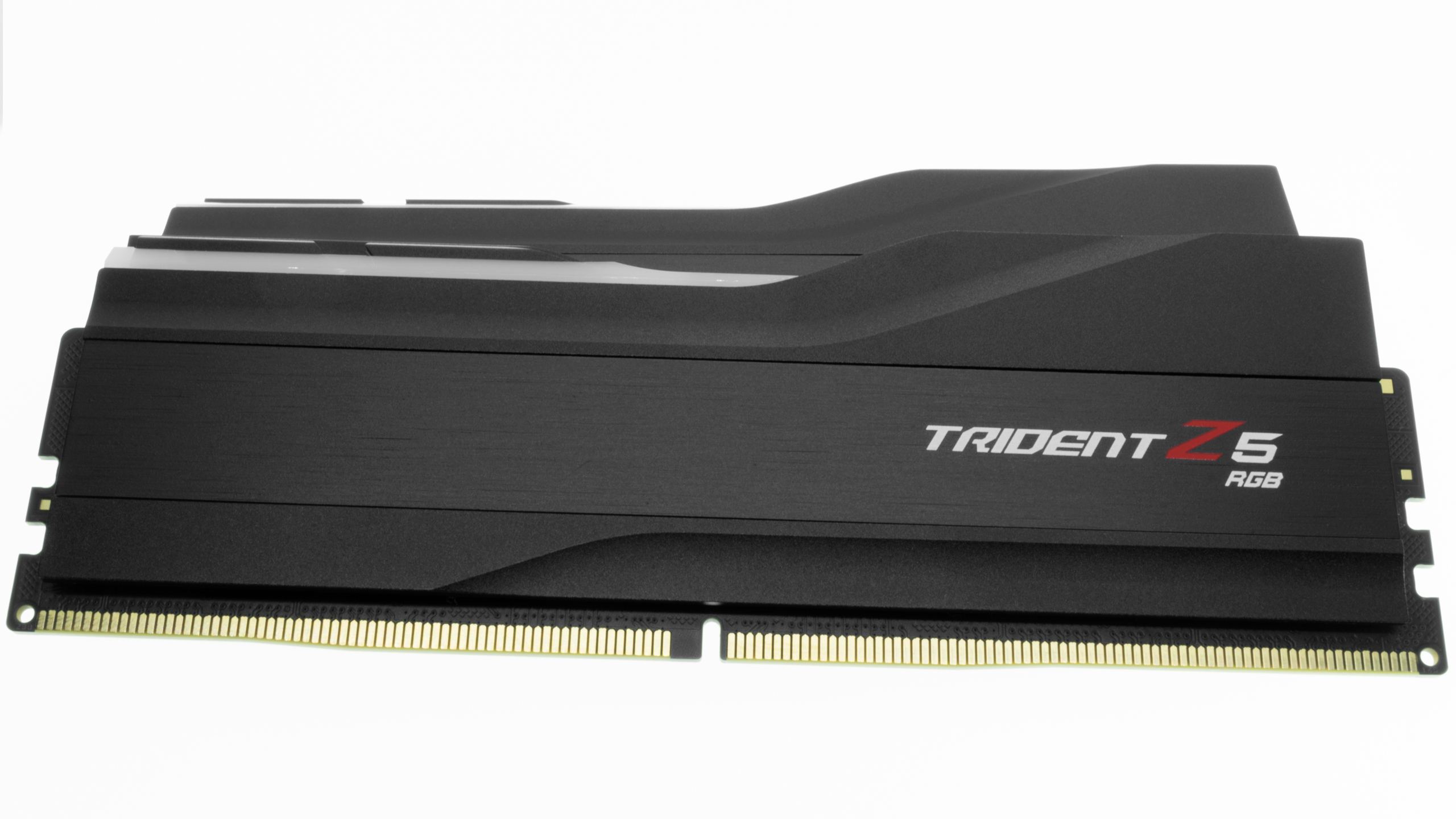


G.Skill’s Trident Z5 RGB memory is among the best-looking DDR5 kits around. The memory comes in two flavors: metallic silver or matte black. On this occasion, we’re taking a look at the latter. Unlike the metallic silver variant that features silver and black tones, the matte black version sports an all-black aluminum heat spreader.
The heat spreader with the translucent RGB light bar on the Trident Z5 RGB isn’t offensively tall; however, the memory module has a height of 42mm (1.65 inches), so you should double-check for compatibility issues either way. You can tweak the lighting using G.Skill’s lightweight Trident Z Lighting Control software or your motherboard. The compatibility list includes Asus Aura Sync, Gigabyte RGB Fusion 2.0, MSI Mystic Light Sync, and ASRock Polychrome Sync.


The Trident Z5 RGB DDR5-6400 memory modules incorporate SK hynix’s H5CG48MEBDX014 (M-die) integrated circuits (ICs). In addition, the power management IC (PMIC) has the “0D=8M 24A” marking. After dumping the memory’s SPD through the CPU-Z software, we found out that Richtek is the maker of this unit.
Like any overclocked DDR5, G.Skill’s memory kit will default to DDR5-4800 with 40-40-40-76 timings. The XMP 3.0 profile configures the data rate up to DDR5-6400, timings to 32-39-39-102, and applies 1.4V to the DRAM voltage. See our PC Memory 101 feature and our How to Shop for RAM story for more on timings and frequency considerations.
Comparison Hardware
| Memory Kit | Part Number | Capacity | Data Rate | Primary Timings | Voltage | Warranty |
|---|---|---|---|---|---|---|
| G.Skill Trident Z5 RGB | F5-6400J3239G16GX2-TZ5RK | 2 x 16GB | DDR5-6400 (XMP) | 32-39-39-102 (2T) | 1.40 | Lifetime |
| G.Skill Trident Z5 RGB | F5-6000U3636E16GX2-TZ5RS | 2 x 16GB | DDR5-6000 (XMP) | 36-36-36-76 (2T) | 1.30 | Lifetime |
| TeamGroup T-Force Delta RGB | FF3D516G6000HC40ABK | 2 x 16GB | DDR5-6000 (XMP) | 40-40-40-80 (2T) | 1.35 | Lifetime |
| Corsair Dominator Platinum RGB DDR5 | CMT32GX5M2B5200C38 | 2 x 16GB | DDR5-5200 (XMP) | 38-38-38-84 (2T) | 1.25 | Lifetime |
| Kingston Fury Beast | KF552C40BBK2-32 | 2 x 16GB | DDR5-5200 (XMP) | 40-40-40-80 (2T) | 1.25 | Lifetime |
| Crucial | CT2K8G48C40U5 | 2 x 8GB | DDR5-4800 | 40-39-39-77 (2T) | 1.10 | Lifetime |

Our DDR5 test system leverages Intel’s Core i9-12900K processor with Corsair’s CUE H100i Elite LCD liquid cooler taking care of the cooling. The flagship Alder Lake chip resides on the MSI MEG Z690 Unify-X motherboard, running the 7D32vH0 firmware. Meanwhile, the MSI GeForce RTX 2080 Ti Gaming Trio is responsible for our gaming RAM benchmarks.
Our Windows 11 installation, benchmarking software, and games are stored on Crucial’s MX500 SSDs, whereas the RM650x feeds our entire system with the necessary juice. Lastly, the Streacom BC1 open bench table houses all of our hardware.
| Intel DDR5 System | |
|---|---|
| Processor | Intel Core i9-12900K |
| Motherboard | MSI MEG Z690 Unify-X |
| Graphics Card | MSI GeForce RTX 2080 Ti Gaming X Trio |
| Storage | Crucial MX500 500GB, 2TB |
| Cooling | Corsair iCUE H100i Elite LCD |
| Power Supply | Corsair RM650x 650W |
| Case | Streacom BC1 |
Intel Performance




















G.Skill’s memory kit boasted excellent performance, clinching the top spot in our application performance chart. The Trident Z5 RGB DDR5-6400 C32 excelled in most of the benchmarks except for Cinebench R23, where it came in fourth.
DDR5 speeds don’t make a huge difference in gaming performance. Nonetheless, the Trident Z5 RGB was only second to G.Skill’s own Trident Z5 RGB DDR5-6000 C36.
Overclocking and Latency Tuning



When you run hardware outside of the manufacturer’s specifications, there’s always a potential risk of damage. That’s the standard caveat with overclocking any piece of hardware, not just memory. We’ve already reached out to SK hynix to inquire about the maximum safe voltage for its ICs, but we haven’t received any feedback on safe voltages for overclocking. However, after speaking with various memory vendors, they’ve agreed that 1.4V is the maximum voltage you would want to pump into DDR5 for an extended time.
Since the Trident Z5 RGB DDR5-6400 C32 already operates with 1.4V, we increased it to 1.45V for some wiggle room. However, the SK hynix M-die ICs were easy to overclock, and we got the memory kit to DDR5-6600 with the exact advertised timings (32-39-39-102) for DDR5-6400.
Lowest Stable Timings
| Memory Kit | DDR5-5200 (1.4V) | DDR5-5400 (1.4V) | DDR5-6000 (1.4V) | DDR5-6200 (1.4V) | DDR5-6400 (1.4V) | DDR5-6400 (1.45V) | DDR5-6600 (1.45V) |
|---|---|---|---|---|---|---|---|
| G.Skill Trident Z5 RGB DDR5-6400 C32 | N/A | N/A | N/A | N/A | N/A | 32-37-37-97 (2T) | 32-39-39-102 (2T) |
| G.Skill Trident Z5 RGB DDR5-6000 C36 | N/A | N/A | 36-33-33-73 (2T) | 36-36-36-76 (2T) | N/A | N/A | N/A |
| TeamGroup T-Force Delta RGB DDR5-6000 C40 | N/A | N/A | 38-38-38-78 (2T) | N/A | 40-40-40-82 (2T) | N/A | N/A |
| Corsair Dominator Platinum RGB DDR5-5200 C38 | 34-37-37-77 (2T) | 40-40-40-76 (2T) | N/A | N/A | N/A | N/A | N/A |
| Kingston Fury Beast DDR5-5200 C40 | 36-37-37-78 (2T) | 38-38-38-78 (2T) | N/A | N/A | N/A | N/A | N/A |
| Crucial DDR5-4800 C40 | N/A | 40-40-40-77 (2T) | N/A | N/A | N/A | N/A | N/A |
The Trident Z5 RGB memory kit has a great CAS Latency (32); however, its other timings need some work. Sadly, there wasn’t a considerable margin for optimization. Even at 1.45V, we only reduced the tRCD, tRP, and tRAS from 39-39-102 to 37-37-97.
Bottom Line
G.Skill’s Trident Z5 RGB DDR5-6400 C32 memory kit is speedy, there’s no doubt about that. The memory would look great in any build and offers some headroom for free performance if you’re into overclocking or don’t mind running the memory kit at a higher voltage. So, the biggest question is whether the memory kit is worth the premium price tag.
The Trident Z5 RGB DDR5-6400 C32 currently retails for $449.99. The Trident Z5 RGB DDR5-6000 C36, which used to sell for $489.99, has dropped to $399.99. So the Trident Z5 RGB DDR5-6400 C32 won’t let you down if you’re after what is the fastest and greatest DDR5 memory kit for the time being. But if top-tier performance isn’t a priority in your book, then the Trident Z5 RGB DDR5-6000 C36 is still a more sensible alternative.
